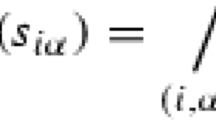Abstract
A theory of fuzzy objects is derived in the category SpaceFP of spaces with fuzzy partitions, which generalize classical fuzzy sets and extensional maps in sets with similarity relations. It is proved that fuzzy objects in SpaceFP can be characterized by some morphisms in the category of sets with similarity relations. A powerset object functor \({\mathcal {F}}\) in the category SpaceFP is introduced and it is proved that \({\mathcal {F}}\) defines a CSLAT-powerset theory in the sense of Rodabaugh.
Similar content being viewed by others
Explore related subjects
Discover the latest articles, news and stories from top researchers in related subjects.References
Di Martino F et al (2008) An image coding/decoding method based on direct and inverse fuzzy tranforms. Int J Approx Reason 48:110–131
Garmendia L et al (2009) An algorithm to compute the transitive closure, a transitive approximation and a transitive opening of a fuzzy proximity. Mathw Soft Comput 16:175–191
Gerla G, Scarpati L (1998) Extension principles for fuzzy set theory. J Inf Sci 106:49–69
Höhle U (2007) Fuzzy sets and sheaves. Part I, basic concepts. Fuzzy Sets Syst 158:1143–1174
Khastan A, Perfilieva I, Alijani Z (2016) A new fuzzy approximation method to Cauchy problem by fuzzy transform. Fuzzy Sets Syst 288:75–95
Močkoř J (2012) Fuzzy sets and cut systems in a category of sets with similarity relations. Soft Comput 16:101–107
Močkoř J (2016) Powerset operators of fuzzy objects. Czech Math J (to appear)
Močkoř J Spaces with fuzzy partitions and fuzzy transform (to appear)
Nguyen HT (1978) A note on the extension principle for fuzzy sets. J Math Anal Appl 64:369–380
Novák V, Perfilijeva I, Močkoř J (1999) Mathematical principles of fuzzy logic. Kluwer Academic Publishers, Boston
Perfilieva I (2006a) Fuzzy transforms and their applications to image compression, Lecture notes in computer science, pp 19–31
Perfilieva I (2006b) Fuzzy transforms: theory and applications. Fuzzy Sets Syst 157:993–1023
Perfilieva I, Novak V, Dvořak A (2008) Fuzzy transforms in the analysis of data. Int J Approx Reason 48:36–46
Perfilieva I, Singh AP, Tiwari SP (2015) On the relationship among F-transform, fuzzy rough set and fuzzy topology. In: Proceedings of IFSA-EUSFLAT. Atlantis Press, Amsterdam, pp 1324–1330
Rodabaugh SE (1997) Powerset operator based foundation for point-set lattice theoretic (poslat) fuzzy set theories and topologies. Quaestiones Mathematicae 20(3):463–530
Rodabaugh SE (2007) Relationship of algebraic theories to powerset theories and fuzzy topological theories for lattice-valued mathematics. Int J Math Math Sci 3:1–71
Rosenthal KI (1990) Quantales and their applications. Pittman Res. Notes in Math. vol 234. Longman, Burnt Mill, Harlow
Solovyov SA (2011) Powerset operator foundations for catalc fuzzy set theories. Iran J Fuzzy Syst 8(2):1–46
Štěpnička M, Valašek R, Numerical solution of partial differential equations with the help of fuzzy transform. In: Proceedings of the FUZZ-IEEE 2005, Reno, Necada, pp 1104–1009
Tiwari SP, Singh Anupam K (2013) Fuzzy preorder fuzzy topology and fuzzy transition system. Logic and Its Applications, Lecture Notes in Computer Science, vol 7750, pp 210–219
Wyler O (1995) Fuzzy logic and categories of fuzzy sets. In: Non-classical logics and their applications to fuzzy subsets. Theory and Decision Library, Series B 32. Kluwer Academic Publishers, Dordrecht, pp 235–268
Yager RR (1996) A characterization of the extension principle. Fuzzy Sets Syst 18:205–217
Zadeh LA (1965) Fuzzy sets. Inf Control 8:338–353
Acknowledgements
This study was funded by the Centre of Excellence Project LQ1602.
Author information
Authors and Affiliations
Corresponding author
Ethics declarations
Conflict of interest
Author declares that he has no conflict of interest.
Human and animal rights
This article does not contain any studies with human participants or animals performed by the authors.
Additional information
Communicated by A. Di Nola.
Rights and permissions
About this article
Cite this article
Močkoř, J., Holčapek, M. Fuzzy objects in spaces with fuzzy partitions. Soft Comput 21, 7269–7284 (2017). https://doi.org/10.1007/s00500-016-2431-4
Published:
Issue Date:
DOI: https://doi.org/10.1007/s00500-016-2431-4




